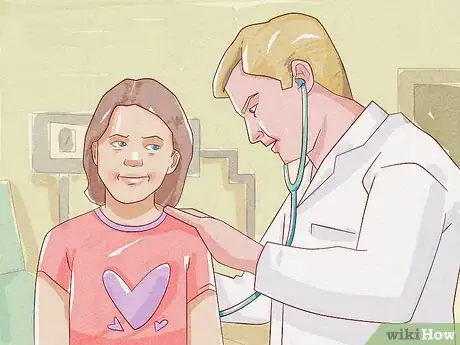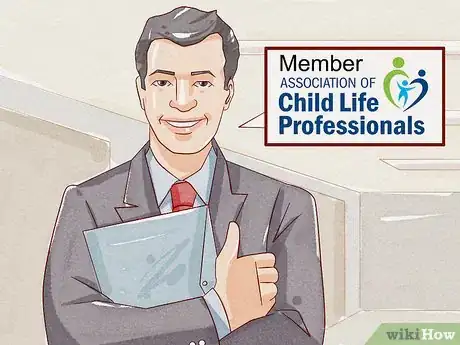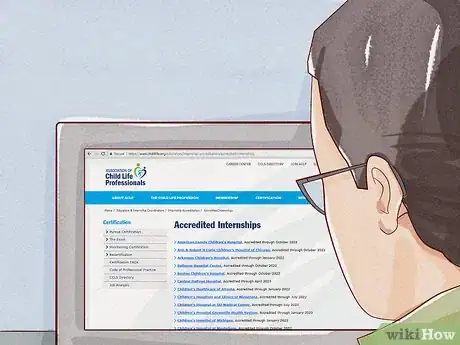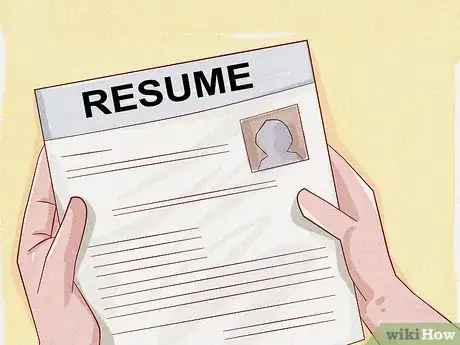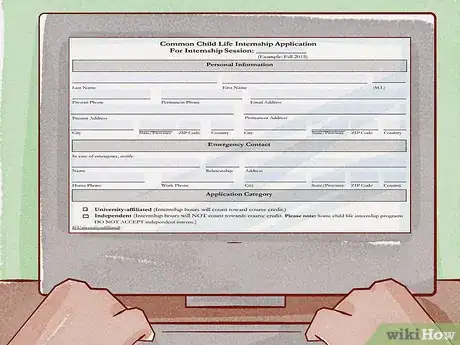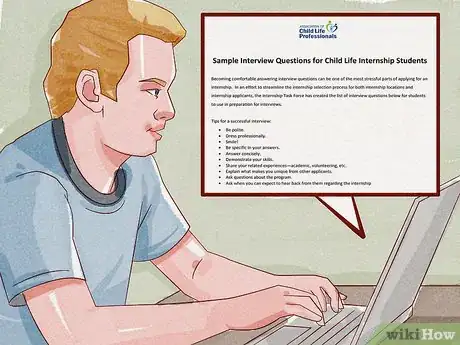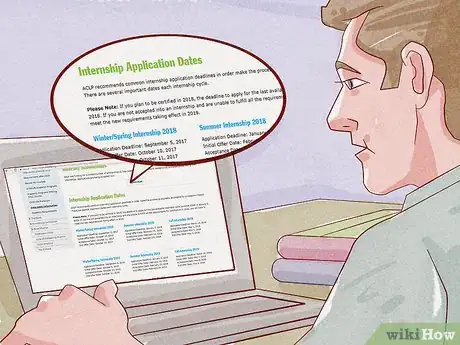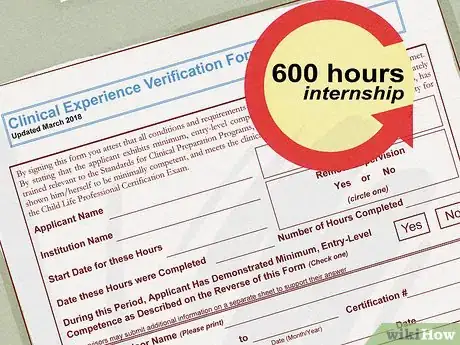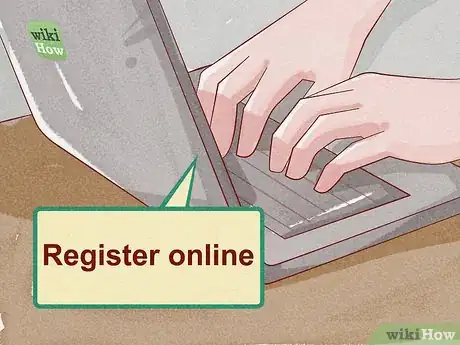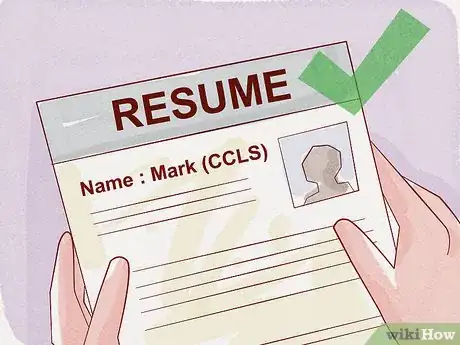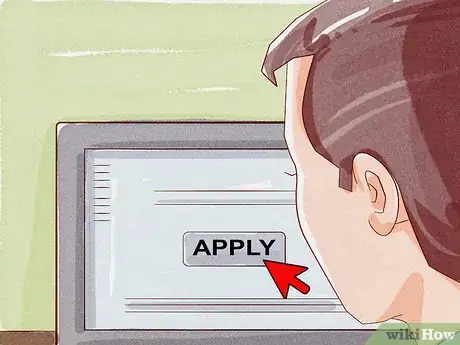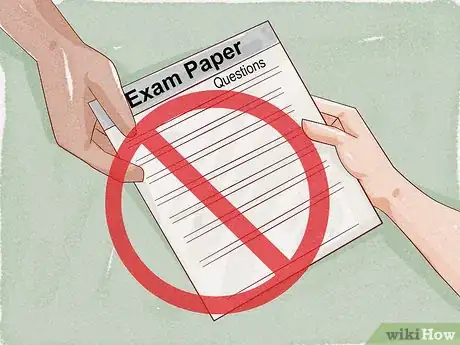This article was co-authored by wikiHow Staff. Our trained team of editors and researchers validate articles for accuracy and comprehensiveness. wikiHow's Content Management Team carefully monitors the work from our editorial staff to ensure that each article is backed by trusted research and meets our high quality standards.
There are 19 references cited in this article, which can be found at the bottom of the page.
This article has been viewed 72,860 times.
Learn more...
Working as a child life specialist can be very rewarding. As a child life specialist, you'll work with children and their families, helping them to navigate through the healthcare system and tackle the obstacles they face related to illness and disability. You can work at hospitals, but you can also find positions at outpatient centers such as dental offices, hospices, clinics, and even camps for children with special health needs.[1] To become a child life specialist, complete a degree, ideally in child life. Then, you must complete 600 clinical hours at an internship, after which you are eligible to take the certification exam through the Association of Child Life Professionals.
Steps
Working on Your Education
-
1Earn a bachelor's degree in child life. To be certified, a bachelor's degree in any field will do. However, a bachelor's degree in child life or similar field is a better option.[2] Similar fields include psychology, child development, child and family studies, and early childhood education.[3]
- Pick a school endorsed by the ACLP to fulfill the certification requirements.
-
2Complete the required coursework to be eligible for certification. If you don't graduate from an ACLP-endorsed program in child life, you can still become certified. You just need to complete 10 specific undergraduate classes to fulfill the same requirement, though you still need a bachelor's degree in another field.[4]
- Take 1 child life course taught by a child life specialist, 2 child development courses that cover birth to 18-years-old, 1 family systems course, 1 play course, 1 loss/bereavement or death/dying course, 1 research course, and 3 more courses in the child life field or a related field.
- The ACLP recommends that you focus on ethics, medical terminology, and anatomy/physiology, but these classes are not required. They can count as your 3 extra classes.
Advertisement -
3Volunteer or complete a practicum. Some programs may require you to have a practicum, which will help you gain valuable experience. Even if yours doesn't, consider volunteering in a related area to gain valuable experience. For instance, you could volunteer to help at a children's hospital or in the pediatric unit of a hospital. Any position in the medical field that gives you experience working with children will be beneficial.
- You might also volunteer at a camp for kids with particular medical needs.
- Ask your professors to recommend places to volunteer. You may even be able to find a paid entry-level position.
-
4Get a master's degree to improve your chances of getting a job. A master's degree in child life is not required to be certified, at least prior to 2022. However, the certification will require a master's degree after 2022. While you can be grandfathered in before that year, a master's degree will make you more competitive in the field.[5]
-
5Become a member of the ACLP to gain access to more jobs. While you don't need to be a member to be a child life specialist, this organization is the agency you will be certified with. Membership comes with benefits, such as access to a search portal for internships, job listings, and more. Plus, you get discounts on things like tests and certification maintenance fees if you're a member.
- A student membership is $72 USD per year as of 2018, while a professional membership is $125 USD per year as of 2018. The main difference is students do not have voting privileges.
Completing Your Internship
-
1Find internships you can apply for by researching hospitals. Check out the hospitals and programs in your area that employ child life specialists, and narrow them by the types of programs you'd like to work in. Look at size, specialties, or areas of research to decide if each program is a good fit for you. Establish at least 10 to 15 places you'd like to apply to.[6]
- Location is also important. You must be willing to move to the area if a program you apply to is not nearby.
- You can search for internships at community.childlife.org/p/cm/ld/fid=37. This tool allows you to narrow down your search by specific criteria. However, you must be a member of ACLP to do so.
-
2Check each program's application requirements to see if you meet them. Some programs require practicum experience, while others do not. Many have GPA requirements. It's important to establish that you meet all of the program's requirements before spending the time to apply.[7]
- Some internships may require you to still be in school or to be affiliated with a specific university, for instance.
- Many schools will accept the ACLP Common Child Life Internship Application, which makes it easier on you, but others do not.
-
3Build a strong resume to use on your application. Often, the application will require a resume. Include any relevant experience you've had in the field, as well as anything else that helps you stand out, such as academic awards or volunteer work you've done.[8]
- If you're not sure how to build a resume, see if your campus has a writing center with tutors who will help you build one.
- Keep your resume organized, clean, and short. Proofread it multiple times to make sure it's free of typos and grammatical errors.
-
4Find professors and bosses who are willing to write references for you. Most professionals know that writing references is part of the job, but you must ask well in advance of the deadline, at least a month ahead of time. Pick people who have praised your work in the past and who you have a repertoire with.[9]
- Provide the person with all the information they need, including your resume and an envelope addressed to where they need to send the letter or the email address. Let them know the program you are applying to, as well as the person they should address the letter to.
- Make sure they know the deadline. Politely inquire 2 weeks later to see how they are progressing.
- Ask them to include specific skills you exemplify.
- Don't forget to send a thank-you card once your letter has been sent.
-
5Apply using the Common Child Life Internship Application. Many programs accept this application, which you can find at https://www.childlife.org/docs/default-source/certification/internships/common-child-life-internship-application.pdf?sfvrsn=18. Fill in biographical information, academic information, and relevant experience. You'll also need to fill in 4 essay questions of 200 words each, if applicable.[10]
- If you're still completing your coursework, have your CCLS instructor fill in the form for the Confirmation of Child Life Course In-Progress. They will also need to fill in a similar form if you're still completing or finished with a practicum.
- Check the ACLP's website for internship deadlines, as most programs follow their schedule. You can find deadlines at https://www.childlife.org/certification/certification-resources/internship-deadlines.
-
6Ace the interview by preparing ahead of time. Use the ACLP's interview guide to prepare. It has sample questions you may be asked in an internship interview. Have someone ask you the question in a practice interview to see how you do. Practicing ahead of time can help calm your nerves.[11]
- You can find the ACLP's guide at https://www.childlife.org/docs/default-source/certification/internships/sample-interview-questions-for-internship-students.pdf?sfvrsn=4.
- Smile, be confident, and hold your head up high! Confidence goes a long way in an interview.
- Remember to dress professionally, and show up on time with a resume in hand.
- Be ready to talk about why you want to enter this profession and what makes you unique.
-
7Accept or decline offers by the acceptance date. The ACLP lays out a schedule, which includes an initial offer date. Programs send out offers to their first choices by this date. You must accept or decline by the acceptance date, which is the day after.[12]
- Stay calm if you haven't received an offer by the initial offer date. After the first round comes the second offer date, where programs send out offers to their second choices.
- Find all the dates you need at https://www.childlife.org/certification/certification-resources/internship-deadlines.
-
8Ensure your supervisor meets the qualifications. Your supervisor must have the child life specialist certification and have already completed 4,000 hours of paid clinical experience in the field. They must be willing to take you on as their intern, guiding you through your education in your clinical internship.
-
9Complete the 600 hours for your internship. After you gain an internship, begin accruing hours. Enter hours on the ACLP's online verification system as you gain them.
- You can also use the Clinical Experience Verification Form, found on the ACLP's website.
Taking the Exam
-
1Complete an Eligibility Assessment to qualify for the exam. This assessment verifies you have the right to take the exam. Find the online application at https://www.childlife.org/certification/students/review-my-courses. Log on, and enter your name and coursework to begin the assessment. Next, enter information about your internship, including your supervisor's name.[13]
- Send in supporting documents, including transcripts from your university or universities. Clinical hours should be verified through the online verification process or the Clinical Experience Verification Form.
- Transcripts can be emailed by your institution to certification@childlife.org or mailed to the following address:
Life Professionals
1820 Ft. Myer Dr.
Suite 520
Arlington, VA 22209. - If you haven't registered, do so by entering a username and password.
- Pay the $75 USD application fee.
-
2Wait for your eligibility notification. The ACLP will send you an email notifying you whether you are eligible or not to sit the exam. If you are eligible, they will provide you with instructions on how to register for the exam.[14]
- If you are denied eligibility, you can send a letter to the Certifying Committee appealing the decision. You must state your reason for appealing in the letter.
-
3Register for the exam online in the required window. To register, go to the Event/Webinar section on the ACLP website. Schedule the exam within the required window stated in your eligibility acceptance letter. Register early as the schedule can fill up.[15]
- Keep in mind that they only give the test approximately 6 weeks out of the year in 3 2-week windows. You will be scheduled for one of these windows. You must register at least 5 days ahead of time.
- Pay the examination fee. The fee is $300 USD for ACLP or $450 USD for non-ACLP members as of 2018.
- Tests are given at IQT testing centers, which are located throughout the United States and the world. You can find your closest location at http://www.isoqualitytesting.com/locations.aspx.
-
4Prepare for the exam by using the ACLP study guide. The ACLP does put out a study guide, but you must purchase it from the website. You can find free resources online provided by other students who are studying. The best preparation is to focus on the areas covered in the test and review your notes and textbooks from your classes. You can also find other resources to review at https://www.childlife.org/docs/default-source/certification/candidate-manual.pdf?sfvrsn=20.[16]
- The exam is divided into professional responsibility, assessment, and intervention. It consists of 150 multiple choice questions. Find a more detailed breakdown of sections at https://www.childlife.org/certification/the-exam/2019-exam-content-outline.
- You can take a practice test at an IQT testing center for $35 USD. Register for one at https://www.iqttesting.com.
-
5Take the exam by keeping your scheduled appointment. Arrive on time; if you arrive more than 20 minutes late, you won't be allowed to take the exam. You will have 4 hours to complete it, and you will take it on a computer.[17]
- Bring your admission document and a government-issued photo ID. You are allowed to bring earplugs but not headphones.
- You may cancel the exam for a refund if you have an emergency or there's severe inclement weather.
-
6Wait for your final score from the ACLP. You will receive your score at the end of the test. However, your official score won't be posted for a few days. You can find it on your ACLP account.[18]
- It is not likely the score will change, but the ACLP does perform a statistical analysis of all scores just in case.
- If you pass, you will just receive a "pass." If you fail, you'll be given your numerical score.
-
7Take the exam again if you don't pass. As long as you still meet the eligibility requirements, you can take the exam as many times as you wish. You do not need to pay the assessment fee again unless your eligibility changes and you need a new assessment. However, you must pay the exam fee each time.[19]
Using Your Child Life Specialist Certification
-
1Add "CCLS" to the end of your name. After passing the certification exam, you are officially a professional child life specialist. Therefore, you can add these letters after your name as a sign of your certification.[20]
- Update your resume to reflect your new certification and experience.
-
2Pay the fees to maintain your certification. Each certification is good for 5 years. For the first 4 years of that certification, you must pay a maintenance fee to ACLP each year to maintain your certification.[21]
- As of 2018, the maintenance fees are $45 USD per year for members and $65 USD per year for non-members, as long as you pay in January. After that, a late fee is added. You must pay by April 1 to maintain your certification.
- Pay online at https://online.childlife.org/clcssa/ssaauthmenu.show_top_menu. For a check, include your certification number in the memo and mail it to the following address:
Certification Maintenance
Association of Child Life Professionals
1820 N Fort Myer Drive
Suite 520
Arlington, VA 22209.
-
3Apply for the position of your choice. At this point, you are a certified professional, free to apply for any position that requires this certification. Search for positions with this certification in your area. You can even apply where you had your internship, as they are already familiar with your abilities.
- The ALCP has job listings on their website, but you must be a member to search them.[22]
-
4Keep your certification by being professional. This certification can be revoked by the ACLP if they decide you have engaged in inappropriate behavior. For instance, they may revoke it if they find out you falsified certification materials.[23]
- They may also revoke it if you violate the Code of Ethical responsibility, found at https://www.childlife.org/docs/default-source/certification/candidate-manual.pdf?sfvrsn=20,
- Cheating on the exam or disclosing questions from the exam is also grounds for your certification being revoked.
- If you are a convicted of a felony, particularly one relating to your profession, your certification may also be revoked.
-
5Re-certify every 5 years. Even though you passed the child life specialist exam, you must show you are staying current by re-certifying. You can either take continuing education courses, known as Professional Development Units, or retake the exam.[24]
Warnings
- Depending on your place of employment, you may be required to work evenings or weekends.⧼thumbs_response⧽
References
- ↑ http://www.mayo.edu/mayo-clinic-school-of-health-sciences/careers/child-life-specialist
- ↑ https://www.childlife.org/docs/default-source/certification/2019-eligibility-details.pdf?sfvrsn=8
- ↑ http://www.mayo.edu/mayo-clinic-school-of-health-sciences/careers/child-life-specialist
- ↑ https://www.childlife.org/docs/default-source/certification/2019-eligibility-details.pdf?sfvrsn=8
- ↑ https://www.unitypoint.org/blankchildrens/services-child-life-specialist-qualifications.aspx
- ↑ https://www.childlife.org/docs/default-source/certification/internships/internship-application-process.pdf?sfvrsn=10
- ↑ https://www.childlife.org/docs/default-source/certification/internships/internship-application-process.pdf?sfvrsn=10
- ↑ https://www.childlife.org/docs/default-source/certification/internships/internship-application-process.pdf?sfvrsn=10
- ↑ https://www.childlife.org/docs/default-source/certification/internships/internship-application-process.pdf?sfvrsn=10
- ↑ https://www.childlife.org/docs/default-source/certification/internships/common-child-life-internship-application.pdf?sfvrsn=18
- ↑ https://www.childlife.org/docs/default-source/certification/internships/sample-interview-questions-for-internship-students.pdf?sfvrsn=4
- ↑ https://www.childlife.org/docs/default-source/certification/internships/sample-interview-questions-for-internship-students.pdf?sfvrsn=4
- ↑ https://www.childlife.org/docs/default-source/certification/candidate-manual.pdf?sfvrsn=20
- ↑ https://www.childlife.org/docs/default-source/certification/candidate-manual.pdf?sfvrsn=20
- ↑ https://www.childlife.org/docs/default-source/certification/candidate-manual.pdf?sfvrsn=20
- ↑ https://www.childlife.org/certification/the-exam/preparing-for-the-exam
- ↑ https://www.childlife.org/docs/default-source/certification/candidate-manual.pdf?sfvrsn=20
- ↑ https://www.childlife.org/docs/default-source/certification/candidate-manual.pdf?sfvrsn=20
- ↑ https://www.childlife.org/docs/default-source/certification/candidate-manual.pdf?sfvrsn=20
- ↑ https://www.childlife.org/docs/default-source/certification/candidate-manual.pdf?sfvrsn=20
- ↑ https://www.childlife.org/docs/default-source/certification/candidate-manual.pdf?sfvrsn=20
- ↑ https://aclp.nationalhealthcarecareers.com/
- ↑ https://www.childlife.org/docs/default-source/certification/candidate-manual.pdf?sfvrsn=20
- ↑ https://www.childlife.org/certification/recertification
About This Article
To become a child life specialist, you'll need to be an effective communicator and someone who enjoys working with people since you'll be tasked with helping children and their families navigate the healthcare system. If that sounds like you, work on getting a bachelor's degree in child life. Or, if you already have a bachelor's degree in something else, you can just complete 10 undergraduate courses that are required for certification. You should also consider getting your master's since it will be a requirement by 2022. For tips on how to pass the exam to become a child life specialist, scroll down!


